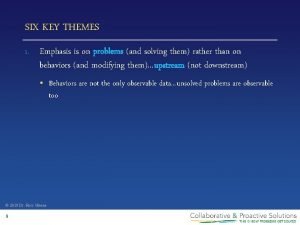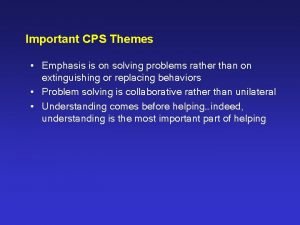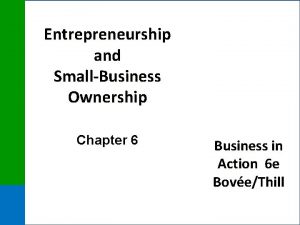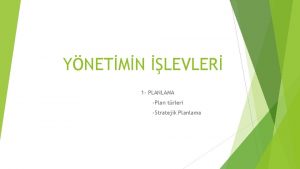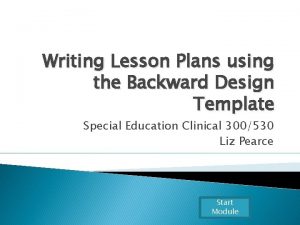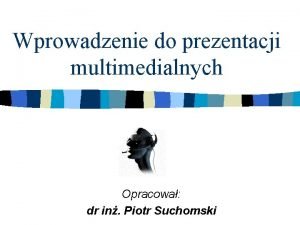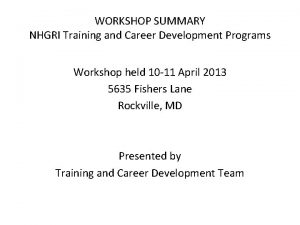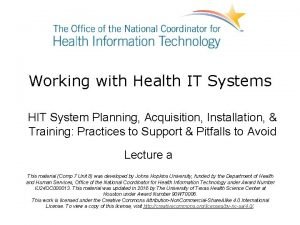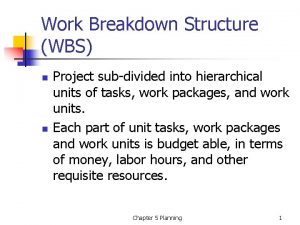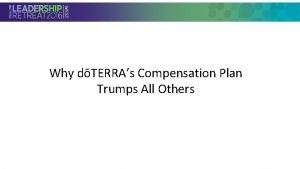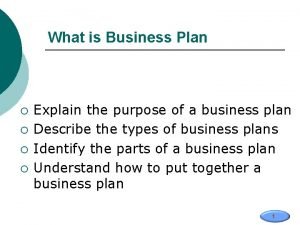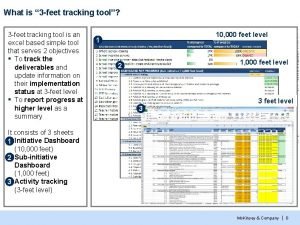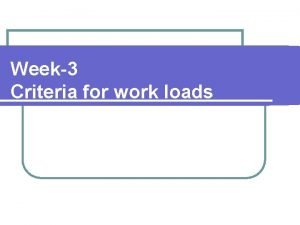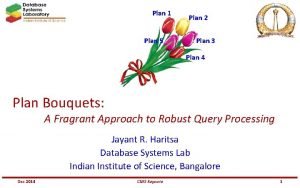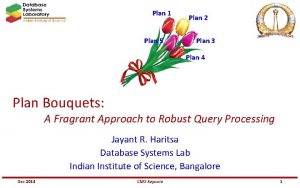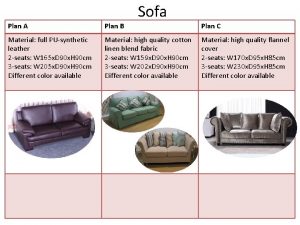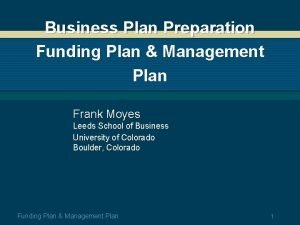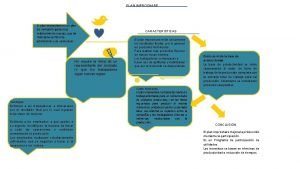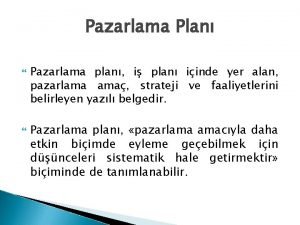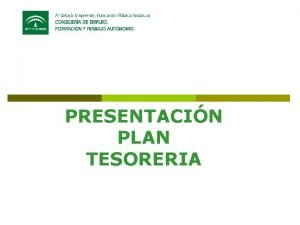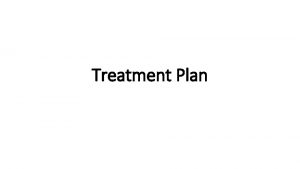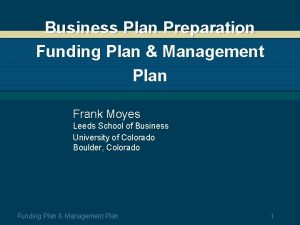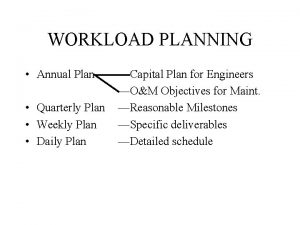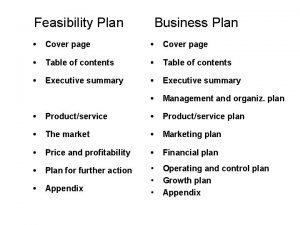Plan 1 Plan 5 Plan 2 Plan 3


![Canonical Query Optimization Framework Declarative Query (Q) Query Optimizer Optimal [Min Cost] Plan P(Q) Canonical Query Optimization Framework Declarative Query (Q) Query Optimizer Optimal [Min Cost] Plan P(Q)](https://slidetodoc.com/presentation_image_h2/0cde41b9e178661eceb79d505c454907/image-3.jpg)

![Proof by Authority [Guy Lohman, IBM] Snippet from April 2014 Sigmod blog post on Proof by Authority [Guy Lohman, IBM] Snippet from April 2014 Sigmod blog post on](https://slidetodoc.com/presentation_image_h2/0cde41b9e178661eceb79d505c454907/image-5.jpg)

























![2 D Performance Analysis • When qa ϵ (ICk-1, ICk] Number of plans on 2 D Performance Analysis • When qa ϵ (ICk-1, ICk] Number of plans on](https://slidetodoc.com/presentation_image_h2/0cde41b9e178661eceb79d505c454907/image-31.jpg)





![Spill. Bound [Followup Paper] Platform-independent for a query Jan 2021 DBMS Course 42 Spill. Bound [Followup Paper] Platform-independent for a query Jan 2021 DBMS Course 42](https://slidetodoc.com/presentation_image_h2/0cde41b9e178661eceb79d505c454907/image-37.jpg)









- Slides: 46

Plan 1 Plan 5 Plan 2 Plan 3 Plan 4 Plan Bouquets: Query Processing without Selectivity Estimation E 0 261 Jayant Haritsa Computer Science and Automation Indian Institute of Science Jan 2021 DBMS Course 1

Talk Theme Declarative query processing with performance guarantees has been a highly desirable but equally elusive goal for the database community over the last three decades. Here, we present a conceptually new approach, called “plan bouquets”, to address this classical problem. [Ph. D Dissertations: Anshuman Dutt, Microsoft Research Redmond Srinivas Karthik, EPFL Switzerland] Jan 2021 DBMS Course 2
![Canonical Query Optimization Framework Declarative Query Q Query Optimizer Optimal Min Cost Plan PQ Canonical Query Optimization Framework Declarative Query (Q) Query Optimizer Optimal [Min Cost] Plan P(Q)](https://slidetodoc.com/presentation_image_h2/0cde41b9e178661eceb79d505c454907/image-3.jpg)
Canonical Query Optimization Framework Declarative Query (Q) Query Optimizer Optimal [Min Cost] Plan P(Q) Operator Execution Cost Estimation Model function of (Hardware, DB Engine) e. g. NL Join = |Router| + |Router| x |Rinner| Jan 2021 DBMS Course 7

Run-time Sub-optimality The supposedly optimal plan-choice from the query optimizer may actually turn out to be highly sub-optimal when the query is executed with this plan. This adverse effect is due to errors in: (a) cost model → limited impact, < 30 % (b) cardinality model → huge impact, orders of magnitude • Coarse statistics, attribute value independence (AVI) assumption, multiplicative error propagation, outdated statistics, query construction, … Jan 2021 DBMS Course 8
![Proof by Authority Guy Lohman IBM Snippet from April 2014 Sigmod blog post on Proof by Authority [Guy Lohman, IBM] Snippet from April 2014 Sigmod blog post on](https://slidetodoc.com/presentation_image_h2/0cde41b9e178661eceb79d505c454907/image-5.jpg)
Proof by Authority [Guy Lohman, IBM] Snippet from April 2014 Sigmod blog post on “Is Query Optimization a “Solved” Problem? ” The root of all evil, the Achilles Heel of query optimization, is the estimation of the size of intermediate results, known as cardinalities. The cardinality model can easily introduce errors of many orders of magnitude! With such errors, the wonder isn’t “Why did the optimizer pick a bad plan? ” Rather, the wonder is “Why would the optimizer ever pick a decent plan? ” Jan 2021 DBMS Course 9

Prior Research (lots!) • Sophisticated estimation techniques VVS LAXMAN – SIGMOD 1999, VLDB 2001, VLDB 2009, SIGMOD 2010, VLDB 2011, … – e. g. wavelet histograms, self-tuning histograms, learning histograms • Selection of Robust Plans RAHUL DRAVID – SIGMOD 1994, PODS 2002, SIGMOD 2005, VLDB 2008, SIGMOD 2010, … – e. g. variance-aware plan selection, LEC (least expected cost) • Runtime re-optimization techniques M S DHONI – SIGMOD 1998, SIGMOD 2000, SIGMOD 2004, SIGMOD 2005, … – e. g. POP (progressive optimization), RIO (Re-optimizer) Several novel ideas and formulations, but lack performance guarantees Jan 2021 DBMS Course 11

Talk Summary • We present “plan bouquets”, a query processing technique that completely eschews making estimates for error-prone cardinalities • Plan Bouquet Approach: run-time discovery of selectivities using a compile-time selected bouquet of plans – provides worst case performance guarantees wrt omniscient oracle that knows the correct selectivities • e. g. for a single error-prone selectivity, relative guarantee of 4 – empirical performance well within guaranteed bounds on industrialstrength environments Jan 2021 DBMS Course 12

Problem Framework Jan 2021 DBMS Course 13

Selectivity Dimensions 100% Example Query: EQ select * from lineitem, orders, part where p_partkey = l_partkey and l_orderkey = o_orderkey and p_price < 1000 sel (part �lineitem) 0% ESS – Error Selectivity Space sel (σ (part)) 100% sel (lineitem �orders) 100% Jan 2021 DBMS Course 14

Performance Metrics 100% • qe – estimated selectivity location in SS • qa – actual run-time location in SS qa(75%, 62%, 85%) • Poe – optimal plan for qe • Poa – optimal plan for qa 0% qe(5%, 2%, 8%) sel (σ (part)) 100% Jan 2021 sel (part �lineitem) DBMS Course 100% sel (lineitem �orders) 15

Main Assumptions • Plan Cost Monotonicity • Perfect Cost Model • Independent SS Dimensions (Mandatory) (relaxed at end of talk) (open question) Cost(P, q 2) =100 q 2 cost(P, qi) < 100 Jan 2021 DBMS Course 16

Contemporary Optimizer Behavior on One-dimensional ESS Jan 2021 DBMS Course 17

( Parametric version of EQ) select * from lineitem, orders, part where p_partkey = l_partkey and l_orderkey = o_orderkey and SEL (PART) = $1 log-scale Parametric Optimal Set of Plans (POSP) P 3 P 4 P 5 P 2 Using Selectivity Injection P 1 NL: Nested Loop Join L: Lineitem O: Orders MJ: Merge Join P: Part HJ: Hash Join log-scale Jan 2021 DBMS Course 18

POSP Performance Profile (across ESS) P 3 P 4 P 5 P 2 P 1 Jan 2021 DBMS Course 19

Sub-optimality Profile (across ESS) P 1 Sub. Opt (qe = 1%, qa = 99%) = 20 P 5 Sub. Opt (qe = 80%, qa = 0. 01%) = 100 P 3 P 2 P 5 Max. Sub. Opt = 100 Avg. Sub. Opt = 1. 8 P 1 Jan 2021 P 4 DBMS Course 20

Plan Bouquet Jan 2021 DBMS Course 21

Bouquet Approach in 1 D ESS Jan 2021 DBMS Course 22

Plan Bouquet Identification Step 1: Draw cost steps with cost-ratio r=2 (geometric progression). P 5 P 3 P 2 IC 6 IC 5 Step 2: Find plans at intersection of optimal profile with cost steps IC 4 P 1 IC 3 P 1 IC 2 P 1 IC 1 P 1 Jan 2021 IC 7 DBMS Course Bouquet = {P 1, P 2, P 3, P 5} 23

Bouquet Execution Let qa = 5% P 3 P 2 P 5 IC 7 IC 6 IC 5 IC 4 IC 3 IC 2 P 1 Jan 2021 qa = 5% DBMS Course IC 1 (1) Execute P 1 with budget IC 1(1. 2 E 4) (2) Throw away results of P 1 Execute P 1 with budget IC 2(2. 4 E 4) (3) Throw away results of P 1 Execute P 1 with budget IC 3(4. 8 E 4) (4) Throw away results of P 1 Execute P 1 with budget IC 2(9. 6 E 4) (5) Throw away results of P 1 Execute P 2 with budget IC 5(1. 9 E 5) (6) Throw away results of P 2 Execute P 3 with budget IC 6(3. 8 E 5) P 3 completes with cost 3. 4 E 5 24

Stupid Ideas? Yes! Very stupid! We are expending lots and lots of wasted effort at both planning time (producing PIC) and at execution time (throwing away work) ! Certainly a recipe for disaster … But, with careful engineering, can actually be made to work surprisingly well → rest of talk Jan 2021 DBMS Course 25

Plan Bouquet Execution Let qa = 5% P 3 P 2 P 1 Jan 2021 qa = 5% DBMS Course (1) Execute P 1 with budget IC 1(1. 2 E 4) Bouquet Cost = 3. 4 E 5 (P 3) + (2) Throw away results of P 1 1. 92 E 5 (P 2) + Execute P 1 E 5 (P 1) + with budget 0. 96 IC 2(2. 4 E 4) 0. 48 results E 5 (P 1)of+P 1 (3) Throw away Execute P 10. 24 E 5 (P 1) + with budget 0. 12 IC 3(4. 8 E 4) IC 7 E 5 (P 1) P 5 (4) Throw=away results of P 1 7. 1 E 5 IC 6 Execute P 1 IC 5 with budget IC 2(9. 6 E 4) Sub. Opt (*, 5%) = 7. 1/3. 4 = 2. 1 IC 4 (5) Throw away results of P 1 Execute P 2 IC 3 With with obvious optimization budget IC 5(1. 9 E 5) IC 2 Sub. Opt(*, 5%)away = 6. 3/3. 4 = of 1. 8 P 2 (6) Throw results IC 1 Execute P 3 with budget IC 6(3. 8 E 5) P 3 completes with cost 3. 4 E 5 26

SO Performance over ESS Native Optimizer Max. Sub. Opt = 100 Avg. Sub. Opt = 1. 8 Bouquet (Enhanced) Max. Sub. Opt = 3. 1 Avg. Sub. Opt = 1. 7 Jan 2021 DBMS Course 27

Worst Case Cost Analysis Bouquet (upper bound) Optimal (lower bound) Pk would complete within its budget when qa ϵ (qk-1, qk] Jan 2021 DBMS Course 28

1 D Performance Bound (Implication of PCM) Best performance achievable by any deterministic online algorithm! Jan 2021 DBMS Course Reaches minima at r = 2 MSO = 4 29

Bouquet Architecture Jan 2021 DBMS Course 30

Connection to Online Bidding Problem • There is an object D with hidden value V in range (1, 100) • Your task is to bid for D until you acquire it under the following rules: – If the bid B < V, then you forfeit B, and bid again – If the bid B ≥ V, then you pay B and acquire D • Your goal is to minimize the worst-case ratio of your total payment to the object value, i. e. min ( (B 1 + B 2 + … + Bk) / V) • Bid doubling algorithm is best possible choice Jan 2021 DBMS Course 31

Bouquet Approach in 2 D SS Jan 2021 DBMS Course 32

2 D Bouquet Identification Cost (normalized) sel-X Jan 2021 Isocost. Contours Planes Plans Cost sel-Y DBMS Course Multiple Plans per contour 33

Characteristics of 2 D Contours s e l Y sel - X 2 D contours • Hyperbolic curves • Multiple plans per contour Jan 2021 Third quadrant coverage (due to PCM) P 2 k can complete any query with actual selectivities(qa) in the shaded region within cost(ICk) DBMS Course 34

Crossing 2 D Contours Covered by all plans in contour Covered by only one plan in contour s e l Y sel - X Entire set of contour plans must be executed to fully cover all locations under IC k Jan 2021 DBMS Course 35
![2 D Performance Analysis When qa ϵ ICk1 ICk Number of plans on 2 D Performance Analysis • When qa ϵ (ICk-1, ICk] Number of plans on](https://slidetodoc.com/presentation_image_h2/0cde41b9e178661eceb79d505c454907/image-31.jpg)
2 D Performance Analysis • When qa ϵ (ICk-1, ICk] Number of plans on ith contour ρ = max(ni) (Using 1 D Analysis) Bound for N-dimensions: Jan 2021 DBMS Course 36

Dealing with large ρ • In practice, ρ can often be large, even in 100 s, making the performance guarantee of 4ρ impractically weak • Reducing ρ – Compile Time: • Anorexic POSP reduction [Cost Greedy] – Run Time: • Explicit Monitoring of Selectivity Lower Bounds • Spilling-based Execution Jan 2021 DBMS Course 37

1) Reducing ρ with Anorexic Reduction • Collapse a large set of POSP plans on a selectivity space into a reduced cover that provides performance within a (1+ λ) factor of the optimal at all locations in the ESS. With λ = 0. 2, invariably obtain a small-sized (< 10) cover. Reduced to 5 plans 76 plans Jan 2021 DBMS Course 38

MSO guarantees (compile time) TPC-H TPC-DS Jan 2021 Query (dim) ρPOSP MSO Bound (POSP) = 4ρPOSP ρreduced (λ=0. 2) MSO Bound (reduced) = 4ρreduced(1+λ) Q 5 (3 D) 11 44 3 14. 4 Q 7 (3 D) 13 52 3 14. 4 Q 8 (4 D) 88 352 7 33. 6 Q 7 (5 D) 111 444 9 43. 2 Q 15 (3 D) 7 28 3 14. 4 Q 96 (3 D) 6 24 3 14. 4 Q 7 (4 D) 29 116 4 19. 2 Q 19 (5 D) 159 636 8 38. 4 Q 26 (4 D) 25 100 5 24. 0 Q 91 (4 D) 94 376 9 43. 2 DBMS Course 39

2) Reducing ρ with Selectivity Monitoring • When (cost-limited) execution of plans on ICk does not complete the query, we know that qa does not lie under ICk – but qa could lie anywhere beyond ICk • By monitoring lower bounds on selectivities during execution (qrun) qa can only be in first quadrant of qrun (# of tuples at a node can only be greater than what has already been seen) (Pi, Pi+5 need not be executed) lesser effective value of ρ Jan 2021 DBMS Course s e l Y sel - X 40

3) Maximizing selectivity movement • The selectivity movement at a node N in the plan tree is increased by “spilling” (dropping without forwarding) the output of N, thereby focusing the entire execution budget on the sub-tree rooted at N. Spill modification to a plan To enhance movement of join selectivity SL, the join output tuples are spilled, instead of being forwarded to the upstream nodes. Jan 2021 DBMS Course 41
![Spill Bound Followup Paper Platformindependent for a query Jan 2021 DBMS Course 42 Spill. Bound [Followup Paper] Platform-independent for a query Jan 2021 DBMS Course 42](https://slidetodoc.com/presentation_image_h2/0cde41b9e178661eceb79d505c454907/image-37.jpg)
Spill. Bound [Followup Paper] Platform-independent for a query Jan 2021 DBMS Course 42

Empirical Evaluation Jan 2021 DBMS Course 43

Experimental Testbed • Database Systems: Postgre. SQL and COM (commercial engine) • Databases: TPC-H and TPC-DS • Physical Schema: Indexes on all attributes present in query predicates • Workload: 10 complex queries from TPC-H and TPC-DS – with SS having upto 5 error dimensions • Metrics: Computed MSO and ASO using Abstract Plan Costing over SS Jan 2021 DBMS Course 44

Performance on Postgre. SQL Log-scale Native Optimizer Bouquet MSO bounds • For many DS queries – MSO improves from ≈106 to ≈10 – ASO improves from ≈102 to ≈ 5 Jan 2021 DBMS Course ASO not compromised to reduce MSO! 45

Performance with COM ⇒Robustness improvements not artifact of a specific engine Jan 2021 DBMS Course 46

Sample Savings in Wall-clock Time Performance Summary In spite of uncalibrated cost model NAT (Postgre. SQL) Enhanced Bouquet Optimal 600 sec 69 sec 16. 1 sec Contour ID Avg. Execution Time (in sec) # Executions (Enhanced Bouquet) Time (in sec) (Enhanced Bouquet) 1 0. 6 2 1. 2 2 3. 1 2 6. 2 3 4. 8 3 14. 4 4 6. 2 3 18. 6 5 12. 2 1 12. 2 6 16. 1 12 68. 7 Total Query based on TPC-H Q 8 Jan 2021 DBMS Course 47

Summary • Plan bouquet approach achieves – bounded performance sub-optimality • using a (cost-limited) plan execution sequence guided by isocost contours defined over the optimal performance curve – robust to changes in data distribution • only qa changes – bouquet remains same – easy to deploy • bouquet layer on top of the database engine – repeatability in execution strategy (important for industry) • qe is always zero, depends only on qa • independent of metadata contents Jan 2021 DBMS Course Important distinction from re-optimization techniques 48

Incorporating Cost Model Error • Jan 2021 DBMS Course 50

For more details, visit project website: dsl. cds. iisc. ac. in/projects/QUEST • Concepts paper: ACM SIGMOD 2014 • Demo paper: VLDB 2014 (Best Demo Award) • Concepts + Implementation: ACM TODS (June 2016) • Followup Work: IEEE ICDE 2017 (Best Student Paper Award) + IEEE TKDE 2017 + VLDB 2019 • Tutorial on RQP: IEEE ICDE 2019, VLDB 2020, Cods-Comad 2020 Jan 2021 DBMS Course 51

Take Away Plan 1 Plan 5 Near Optimal Query Execution Performance Plan 2 Plan 3 Plan 4 SQL Query Do you know the correct selectivities ? Jan 2021 DBMS Course 52
 Problem solving plan (plan b flowchart)
Problem solving plan (plan b flowchart) Place/location/destination plan a
Place/location/destination plan a Short medium and long term planning in education
Short medium and long term planning in education Problem solving plan (plan b flowchart)
Problem solving plan (plan b flowchart) Micro lesson example
Micro lesson example Problem solving plan (plan b flowchart)
Problem solving plan (plan b flowchart) New jersey plan vs virginia plan
New jersey plan vs virginia plan Gambar stowage plan
Gambar stowage plan Perencanaan lokasi pabrik dan tata letak fasilitas
Perencanaan lokasi pabrik dan tata letak fasilitas Man's plan vs god's plan
Man's plan vs god's plan Virginia plan and new jersey plan venn diagram
Virginia plan and new jersey plan venn diagram Constitutional convention compromise
Constitutional convention compromise People don t plan to fail they fail to plan
People don t plan to fail they fail to plan Management plan in business plan
Management plan in business plan Biznis plan za kozmeticki salon
Biznis plan za kozmeticki salon Sample of study plan
Sample of study plan Social media executive summary example
Social media executive summary example Sürelerine göre planlar
Sürelerine göre planlar Schlieffen plan ww1
Schlieffen plan ww1 Business plans derby
Business plans derby Backward mapping template
Backward mapping template List of replacement behaviors
List of replacement behaviors Wrap crisis plan examples
Wrap crisis plan examples Plan prezentacji
Plan prezentacji Gender action plan world bank
Gender action plan world bank Gender action plan world bank
Gender action plan world bank Nhgri strategic plan
Nhgri strategic plan Hit plan
Hit plan Wbs for trip planning
Wbs for trip planning How to write strategic plan
How to write strategic plan Plexus ranks
Plexus ranks Ia resp diploma plan
Ia resp diploma plan Stalins goal
Stalins goal Wellness recovery action plan examples
Wellness recovery action plan examples Plan prodaje primer
Plan prodaje primer Selecttype
Selecttype Pretest: developing an academic and career plan
Pretest: developing an academic and career plan 3 feet plan
3 feet plan Counselling action plan
Counselling action plan Career plan presentation example
Career plan presentation example Bizplanbuilder
Bizplanbuilder What is 7elife
What is 7elife Brand new supervisor herbalife
Brand new supervisor herbalife Breakout plan
Breakout plan Poche floor plan
Poche floor plan How to write time plan
How to write time plan What is a strand in a lesson plan
What is a strand in a lesson plan
